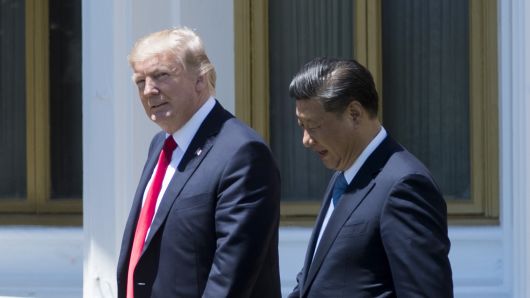
Jim Watson | AFP | Getty Images
President Donald Trump (L) and Chinese President Xi Jinping walk together at the Mar-a-Lago estate in West Palm Beach, Florida, April 7, 2017.
The United States and China are exploring a trade pact that would halt further tariffs from Washington in exchange for new talks looking at major changes to Beijing’s economy policies, officials from both governments told The Wall Street Journal.
Discussion between the two nations has reportedly occurred via telephone over the past several weeks, with both sides eager to quell mounting trade tensions ahead of a meeting between President Donald Trump and China President Xi Jinping at a Group of 20 summit in Buenos Aires.
The new talks would center around so-called trade “architecture,” the Journal reported, a broad term referring to a barrage of issues the U.S. has wanted Beijing to remedy, including protection for intellectual property and subsidies to state-owned enterprises.
Though both sides appear hopeful a trade truce can be reached, there has been little room for optimism that the two economic powerhouses will reach a deal in the near-term.
A official confirmed to CNBC’s Eamon Javers that White House trade policy advisor and well-known China hawk Peter Navarro will be attending the crucial meeting between Trump and Xi this week. Navarro, a proponent of the Trump administration’s use of tariffs said earlier this min that any agreement between the two countries will be on Trump’s terms and not subject to Wall Street intervention.
The White House has slapped multiple rounds of tariffs on goods imported from China throughout 2018 as a part of the president’s move to protect American business interests. Trump, along with U.S. Trade Representative Robert Lighthizer, hope that the sanctions will force overseas counterparts to entertain more favorable trade deals.
The president has had mixed success with the tactic, producing both a revised version of the North American Free Trade Agreement as well as headaches for longtime economic allies like Canada and the European Union. Trump has specifically targeted Beijing with tariffs for alleged intellectual property theft as well as contributing to the massive trade imbalance between the two nations.
In September, the White House announced a round of tariffs on another $200 billion of products imported from China at a 10 percent rate. Should Trump and Xi fail to broker a trade truce before 2019, the tax will climb to 25 percent.
Click here for the original story from The Wall Street Journal.
 EU News Digest Latest News & Updates
EU News Digest Latest News & Updates



